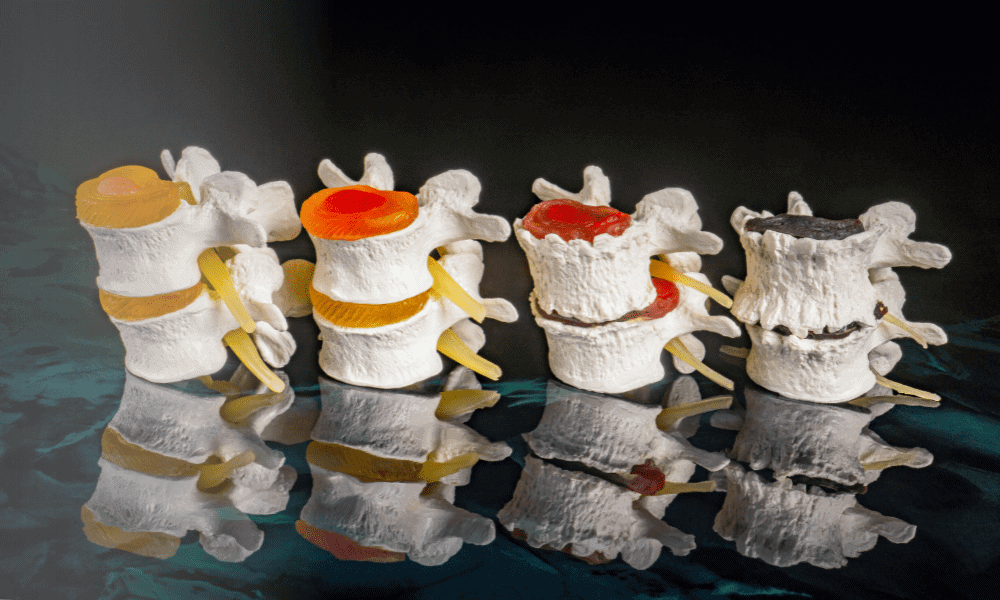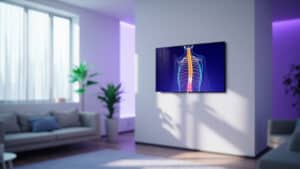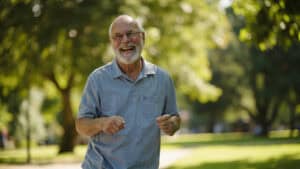Managing Lumbar Degenerative Disc Disease: Innovative Treatment Options
Introduction
Lumbar Degenerative Disc Disease (LDDD) is a common condition that can cause significant discomfort and disability.
Dr. Matthias Wiederholz, a board-certified pain management specialist at Performance Pain and Sports Medicine, has dedicated his career to understanding and treating conditions like LDDD.
His expertise and experience equip him to shed light on this often misunderstood condition, its causes, symptoms, diagnosis, and innovative treatments, including the groundbreaking Discseel® Procedure.

What is Lumbar Degenerative Disc Disease?
LDDD is a condition characterized by the deterioration or breakdown of the discs in the lumbar region, the lower part of the spine.
These discs act as shock absorbers between the vertebrae, providing flexibility and preventing damage.
When they deteriorate, it can lead to pain, weakness, or numbness in the lower back and legs, significantly affecting a person’s quality of life.
Common Misconceptions about the Term “Disease”
Despite its name, LDDD is not a disease in the conventional sense. It doesn’t involve an infection or an immune response. Instead, it refers to the natural, age-related process of disc degeneration.
However, for some individuals, this process can cause severe pain and discomfort, significantly impacting daily life.
Anatomy of the Spinal Disc
Role and Function of Spinal Discs
Spinal discs are integral to the body’s structure and function. They serve as shock absorbers between the vertebrae, enabling us to move, bend, and twist with ease.
They also help maintain the spacing between the vertebrae, which is vital for the health of the nerves that run through the spine.
Structure of Intervertebral Discs
| Part of the Disc | Description |
|---|---|
| Nucleus Pulposus | The soft, gel-like center of the disc. |
| Annulus Fibrosus | The tough, rubbery exterior of the disc. |
Each disc is composed of two parts: a soft, gel-like center known as the nucleus pulposus, and a tough, rubbery exterior called the annulus fibrosus.
In LDDD, these discs can dry out and lose their flexibility, elasticity, and shock-absorbing characteristics, leading to increased susceptibility to damage.
Causes and Risk Factors
Age-related Changes in the Disc
As we age, our intervertebral discs naturally lose hydration and elasticity, making them more prone to wear and tear. This degeneration process is a significant risk factor for developing LDDD.
Impact of Daily Activities and Injuries
Daily activities, especially those involving heavy lifting or twisting, can put additional stress on the lower back, contributing to disc degeneration.
Similarly, injuries can cause inflammation and damage to the discs, accelerating the degeneration process.
Therefore, maintaining proper body mechanics during physical activities is crucial in preventing disc damage.
Symptoms and Diagnosis
- Persistent lower back pain that may radiate to the hips and legs
- Pain that worsens when sitting or bending
- Numbness or tingling in the lower extremities
- Muscle weakness or spasms
Common Symptoms of Lumbar Degenerative Disc Disease
Symptoms of LDDD can vary greatly among individuals. However, the most common ones include persistent lower back pain that may radiate to the hips and legs, pain that worsens when sitting or bending, and numbness or tingling in the lower extremities.
Some people may also experience muscle weakness or spasms, making daily activities challenging.
Diagnostic Procedures and Their Importance
An accurate diagnosis of LDDD is crucial for effective treatment planning. This typically involves a comprehensive physical examination, review of medical history, and imaging tests like X-rays, MRI, or CT scans.
These tests can help identify disc damage and rule out other potential causes of pain, ensuring the most effective treatment plan can be established.
Treatment Options
| Treatment Method | Description |
|---|---|
| Physical Therapy | Exercises to strengthen the muscles that support the spine, improving flexibility and reducing pain. |
| Medications | Over-the-counter pain relievers, NSAIDs, and muscle relaxants to manage pain and inflammation. |
| Lifestyle Modifications | Maintaining a healthy weight, practicing good posture, and avoiding activities that exacerbate pain. |
| Discseel® Procedure | An innovative non-surgical treatment that involves injecting an FDA-approved biologic into the damaged or torn disc. |
| Surgical Interventions | Disc replacement or spinal fusion for severe cases of LDDD. |
Non-surgical Treatment Methods
Non-surgical treatments for LDDD are often the first line of defense and can be highly effective. These include physical therapy, medications, and lifestyle modifications.
Physical therapy exercises can help strengthen the muscles that support the spine, improving flexibility and reducing pain.
Medications, such as over-the-counter pain relievers, NSAIDs, and muscle relaxants, and prescription pain patches can help manage pain and inflammation.
Lifestyle modifications, like maintaining a healthy weight, practicing good posture, and avoiding activities that exacerbate pain, can also help manage symptoms.

One innovative non-surgical treatment is the Discseel® Procedure, which involves injecting an FDA-approved biologic into the damaged or torn disc. This biologic promotes healing and helps restore the disc’s function, offering hope for many patients who haven’t found relief through other treatments.

Surgical Interventions and Their Benefits
If conservative treatments fail to provide relief, surgical interventions may be considered.
These can include disc replacement or spinal fusion. These procedures can significantly reduce pain and improve quality of life, offering a more permanent solution for severe cases of LDDD.

Living with Lumbar Degenerative Disc Disease
Managing Pain and Discomfort
Living with LDDD can be challenging, but with the right treatment plan, regular exercise, and a healthy lifestyle, patients can manage their pain and lead fulfilling lives.
Techniques such as mindfulness and meditation can also help manage stress and improve mental well-being, contributing to overall pain management.
Importance of Consulting with Spine Specialists
If persistent back pain is affecting your life, it’s essential to consult with a spine specialist like Dr. Wiederholz.
Early diagnosis and treatment can prevent further degeneration and improve your quality of life, allowing you to return to your regular activities with less pain and discomfort.
Conclusion
Emphasizing the Importance of Personalized Treatment
Every patient is unique, and so should be their treatment plan. At Performance Pain and Sports Medicine, we believe in personalized treatment plans tailored to each patient’s specific needs and lifestyle.
This approach ensures that each patient receives the most effective treatment for their specific condition.
Encouraging Regular Check-ups and Monitoring
Regular check-ups and monitoring are crucial in managing LDDD. It’s important to keep an open line of communication with your doctor and report any changes in your symptoms.
Regular monitoring can help adjust treatment plans as needed, ensuring optimal pain management.
Dr. Wiederholz is available for consultations and the Discseel® procedure at the Houston TX and Lawrenceville NJ locations. Don’t let chronic back pain control your life. Reach out today, and let’s work together towards a pain-free future.

















